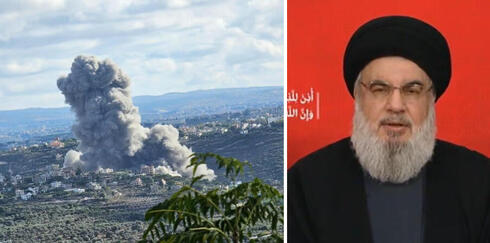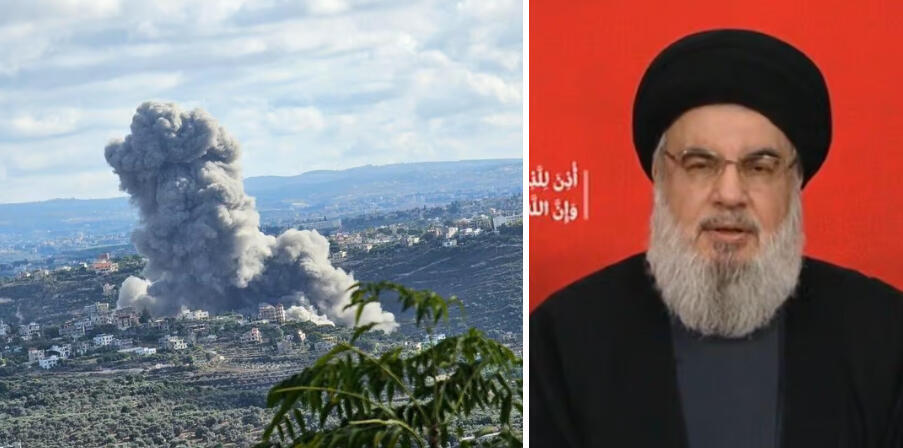
Hezbollah’s rocket arsenal: myths, realities, and the limits of Israeli airstrikes
Experts weigh in on the true damage to Hezbollah’s firepower and what remains in its vast missile stockpile.
The estimate from an unknown source, suggesting that the Israeli Air Force has destroyed about half of Hezbollah's rocket arsenal in recent days, should be taken with a grain of salt. According to security sources, who are familiar with the size, arsenal, and capabilities of the Shiite terrorist organization, this is likely an exaggerated claim. This does not, however, diminish the significance of Israel's intelligence and military achievements in the past few days on the northern front, following about a year of attrition warfare during which the Galilee was subjected to daily rocket fire from Lebanon, forcing tens of thousands of residents to flee.
The hundreds of airstrikes targeting buildings and homes in southern Lebanese villages, used for both residential purposes and as storage for rockets to be launched into Israel, are the result of long-term intelligence-gathering efforts. The bombing of weapons depots and launch sites deep within Lebanon, alongside the elimination of senior Hezbollah members in surgical strikes in the Da'aheh district of Beirut has shaken the organization. This is further compounded by Hezbollah's inability to recover from the recent pager attack, which injured about 4,000 of its operatives—an incident it attributes to Israel.
The claim by an unidentified Israeli source about destroying approximately 50% of Hezbollah's rocket capabilities might encounter a more challenging reality as the fighting continues. Even though the IDF has escalated its efforts in the north, Hezbollah remains a formidable and dangerous adversary, retaining significant firepower for a long-term war of attrition that could still inflict substantial damage. Brigadier General (res.) Ran Kochav, a former commander of the Israeli Air and Missile Defense Forces, shares this assessment. In an interview with Calcalist, he stated, "Anyone claiming that half of Hezbollah's rockets were destroyed is wrong and misleading. Even if true—and I don’t believe it is—Hezbollah still possesses tens of thousands of additional rockets across different ranges. Whoever thinks otherwise should publicly clarify what was left undone. We haven’t destroyed half of Hezbollah’s precision missile array, nor have we eliminated Hassan Nasrallah. The government, belatedly, has included the return of northern residents to their homes in its list of war objectives, but we have yet to recover all of the hostages in Gaza, living or dead, nor have we destroyed 50% of Hezbollah’s rockets. It would be wise to proceed with more modesty."
Tal Beeri, Head of the Alma Center Research Department, suggests that the extensive damage to Hezbollah’s missile and rocket array likely pertains to medium-range missiles. These rockets, designed to strike targets between 80 km and 200 km away, include the Fajr-2 and the Zelzal. Beeri estimates that on the eve of the conflict, Hezbollah had approximately 5,000 medium-range rockets, of which around 2,500 may have been destroyed in the recent waves of Israeli airstrikes. Hezbollah is also estimated to still possess another 5,000 long-range rockets and missiles with ranges exceeding 200 km. Most of its arsenal, however, consists of short-range rockets (up to 80 km), where the bulk of its firepower lies—an array of approximately 65,000 rockets, including Grad, Fajr-1, and Fajr-3 models.
This array also includes Burkan rockets—essentially flying barrels of explosives weighing up to half a ton, with a maximum range of about 10 km. The Falaq-1 rockets, which carry warheads of more than 100 kg, were used by Hezbollah in late July to massacre 12 children and teenagers playing soccer in Majdal Shams. Alma’s data reduce Hezbollah’s total rocket stockpile to approximately 75,000, down from earlier estimates of around 150,000. According to the research center, Hezbollah also holds about 150,000 mortar shells with ranges of up to 10 km, along with various anti-tank missiles like the Kornet and Almas, which have ranges between 2 km and 16 km.
Approximately 10% of Hezbollah’s total rocket and missile stockpile is considered to be precision-guided, which equates to a few thousand rockets tailored to strike specific targets with high accuracy. The Israeli Air Force has frequently targeted shipments of precision-guidance components from Iran through Syria to Lebanon for use in Hezbollah’s missile upgrade program. Despite these efforts, some shipments have made it through, contributing to the organization's enhanced missile capabilities.
Even if half of Hezbollah's rocket arsenal were destroyed, tens of thousands of rockets would remain at its disposal. Beyond rockets, Hezbollah also has coastal missiles that could threaten Israeli naval vessels, merchant ships, and gas rigs in the Mediterranean. These include the older Chinese C-802 missile, which Hezbollah used during the Second Lebanon War to strike an Israeli navy ship, killing four sailors. There is also a strong likelihood that Hezbollah possesses Russian Yakhont coastal missiles and similar models made in Iran, all designed to target naval assets from land.
Additionally, Hezbollah has cruise missiles. Israeli Defense Forces (IDF) spokesman Brigadier General Daniel Hagari recently revealed that Hezbollah is storing DR-3 cruise missiles in private homes in southern Lebanon, ready for launch towards Israel. These missiles can carry massive warheads, up to 300 kg, and threaten targets deep within Israel, as well as naval targets. The cruise missiles are based on jet-powered UAV technology, originally developed by the USSR. Hezbollah also operates a sophisticated UAV system, largely supplied by Iran and supplemented by its own production. According to estimates, Hezbollah possesses about 2,500 UAVs of various types and ranges, including the Ababil-T, which carries warheads of several dozen kilograms, and the Mirsad-1, which carries up to 40 kg, with a range of about 120 km.
Israel has prepared extensively for this confrontation. Over the past year, improvements were made to the air defense systems and the air force’s ability to counter Hezbollah’s frequent UAV incursions. These enhancements involved upgrades to the Iron Dome system and greater operational experience in dealing with UAVs. However, intercepting such aircraft at low altitudes remains dangerous due to the required precision and the proximity to the ground.
The Israeli defense establishment is also working on technological innovations to improve countermeasures against UAVs and anti-tank missiles frequently launched from southern Lebanon towards Israeli border communities. To combat Hezbollah’s extensive rocket and missile arsenal, Israel relies on a multi-layered defense system that includes the Arrow 2 and 3, David's Sling, and the Iron Dome. By next year, Rafael is expected to complete the development of the Magen Or laser defense system, which should optimize interception capabilities and reduce the need for conventional interceptors. Israeli naval vessels are also equipped with naval versions of the Iron Dome and the Barak MX air defense system.
Should the IDF launch a ground invasion into southern Lebanon—a scenario not currently under consideration but still possible—the Israeli armored corps would be better protected than in 2006, thanks to the installation of the Trophy active protection system on Merkava tanks and Namer APCs. Elbit Systems is also set to deliver the Iron Fist active protection system for heavy-duty APCs and D-9 bulldozers.
However, ground fighting in southern Lebanon would likely force the IDF to confront a vast and sophisticated underground network built by Hezbollah over decades. These tunnels, some designed to be “infiltration tunnels” that could endanger advancing IDF troops, also serve as strategic command centers and missile storage facilities. Hezbollah has constructed huge tunnel complexes in the mountains, including the "Imad 4" installation, which the group recently showcased in a video intended to intimidate Israel. According to Alma’s research, North Korean experts helped build these tunnels, drawing on their experience from similar projects in the demilitarized zone (DMZ) between North and South Korea. Although North Korea’s ambitions to invade South Korea may never materialize, the expertise gained from those projects has been of great interest to Hezbollah and Iran, and the North Koreans have eagerly shared their knowledge.














